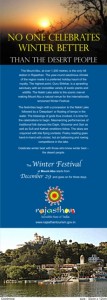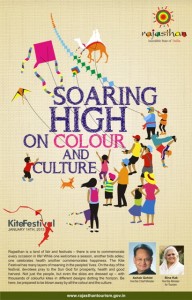In a land of 330 million deities, the risk lies more in running out of devotees than running short on festivals. Staking a righteous claim to the title ‘land of festivals’ is almost every second state of the republic – starting in the south from Tamil Nadu, Kerala and Karnataka to Bihar, Uttar Pradesh, Rajasthan to West Bengal and further on to Nagaland. Birth of deities, death of saints, change of seasons, arrival of rains and harvest, a festival for selling camels, another for buying cattle…the reasons are as recherché as well as regular as anywhere in the world. But these are not enough to satiate our festive appetites.
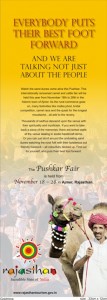 Exploring newer horizons, delving into more esoteric realms ostensibly to celebrate the niche – there are some three to four annual additions to the festival calendar. While religion continues to be the most popular reason, a host of music-centric festivals are also catching up and some overtaken even the regulars by a wide attendance margin. Sunburn, Fireflies, Hornbill, Storm, Rajasthan International Folk Festival and Sulafest… all surpassed organisers’ kickoff expectations. Despite its thrust on glamping – the scourge of adventure travel, according to purists – a music festival on the Kanoi sand dunes on Jaisalmer outskirts which was flagged off recently also witnessed a decent turnout. Probably in terms of numbers, definitely in terms of spread, visibility and accessibility, Rajasthan has surpassed the rest of the ‘land of festivals.’
Exploring newer horizons, delving into more esoteric realms ostensibly to celebrate the niche – there are some three to four annual additions to the festival calendar. While religion continues to be the most popular reason, a host of music-centric festivals are also catching up and some overtaken even the regulars by a wide attendance margin. Sunburn, Fireflies, Hornbill, Storm, Rajasthan International Folk Festival and Sulafest… all surpassed organisers’ kickoff expectations. Despite its thrust on glamping – the scourge of adventure travel, according to purists – a music festival on the Kanoi sand dunes on Jaisalmer outskirts which was flagged off recently also witnessed a decent turnout. Probably in terms of numbers, definitely in terms of spread, visibility and accessibility, Rajasthan has surpassed the rest of the ‘land of festivals.’
Definitely this is indeed surprising. Here, a state mostly of barren sand dunes, scorching sun and drought-prone, dismal education levels and gender equality tilting the festival scale towards it. Then, these are exactly the same reasons which have upped the gaiety quotient.
The legends of colour and grace
Barren brown is dreary. Endless vistas of undulating sand don’t do a lot for colour either. An unrelenting weather can be daunting, sucking out your very will to live. And yes, camels can be hard to maintain more than dogs and cats. Then, this is when that undefeatable thing called ‘human spirit’ takes over; the indefatigable will of the desert people manifests itself in the many traditional performances which reflect a new zest to live itself. Dances like ghoomar and gheer, khayal and kachigori are vibrant and engrossing in equal measure. It is almost like with the twirling around, interpreting the narrative in gestures to the accompaniment of the sarangi, ektara, damru and nad, they are in a way expressing their gratitude to the inimical elements for divesting them with so much imagination, vigour and art.
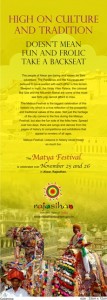 And it is not just in the motion one finds so much grace and beauty; there is art in everyday. Ghaghra and odhni, banda and bugatari – there is probably no other state in the country where there is so much single-minded focus on colour. From simple reasons of heat reflection to more profound ones like scaring away the dune spirits, colour comes in every garb. Topping the list of the desert garb is indeed pagadi or the turban. While mostly a man thing, historic evidences point to women too using turbans several centuries ago. The type of turban was also decided by hierarchy or the societal standing the person enjoyed. The pagadi, variously called the safa or shamla, also denotes not just the community and social status of the wearer, but his occupation and economic conditions as well. The riotous colours and the twirls come together in the festivals which are more than occasions – as denoted by harvest seasons, changing sun and moon positions or commerce – but are also the much-needed physical vents to prolonged lethargies of staying indoors. The anticipated merrymaking makes up for the pent-up yearning to feel and come alive; a reliving of their valiant histories, where the spirit never surrendered.
And it is not just in the motion one finds so much grace and beauty; there is art in everyday. Ghaghra and odhni, banda and bugatari – there is probably no other state in the country where there is so much single-minded focus on colour. From simple reasons of heat reflection to more profound ones like scaring away the dune spirits, colour comes in every garb. Topping the list of the desert garb is indeed pagadi or the turban. While mostly a man thing, historic evidences point to women too using turbans several centuries ago. The type of turban was also decided by hierarchy or the societal standing the person enjoyed. The pagadi, variously called the safa or shamla, also denotes not just the community and social status of the wearer, but his occupation and economic conditions as well. The riotous colours and the twirls come together in the festivals which are more than occasions – as denoted by harvest seasons, changing sun and moon positions or commerce – but are also the much-needed physical vents to prolonged lethargies of staying indoors. The anticipated merrymaking makes up for the pent-up yearning to feel and come alive; a reliving of their valiant histories, where the spirit never surrendered.
The visitors are a bonus, actually.
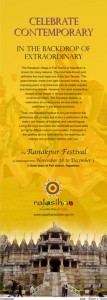 Festivals: An amaranthine array
Festivals: An amaranthine array
Once the cloak of bearable climate settles over the desert state, it erupts literally with festivals. Reciprocating the effervescence with fervour are the hordes of tourists who descend in hordes. Though the season sets in by October, the state waits another month to ante up. Come November and the kick off is in quick succession and goes on till summer sets in by around April.
Deepotsava (November 10, 11)
Celebrated in Jaipur, this is a festival dedicated to Lord Krishna. In accordance to the ancient texts called Skanda Purana, anybody who lights a lamp in the name of Lord Krishna in the month of Kartik (November) will be blessed with limitless beauty and wealth.
Pushkar (November 18 – 28)
This is an internationally renowned camel fair held in the historic town of Ajmer. Yes, most of those images of the fascinated-looking foreigners squatting with flowing bearded, naked sadhus sharing puffs from chillums are mostly from this fair.
Matsya (November 25, 26)
This is a tribute to the valiance of the people of the historic Alwar. Spread over two days, many events – mostly war – are relived during the festivities along with a host of fun competitions which pulls in every kind of reveler.
This is rustic Rajasthan at its best. Jhalawar, a hinterland of Rajasthan, comes alive on this day of Full Moon or Kartik Purnima. Livestock as well as handicrafts are traded during the fair.
Ranakpur (November 28 – December 1)
The magnificent Sun Temple in the Ranakpur village in Pali, Rajasthan, comes alive during the festival. Cultural recitals rooted in history as well as contemporary ones are performed over three days. Giving a better taste of the state are the many food and handicraft stalls.
Winter Festival (December 29)
Mount Abu is the only hill station in Rajasthan. The Winter Festival begins with a religious procession to the Nakki Lake here. There is also a sanctuary up here with an impressive collection of wild flora and fauna. In addition to poetry reading, there is also hot air ballooning and rowing competition.
The line-up for 2013 is below; read on before you call Red Bus.
Kite Festival (January 14)
The Kite Festival has many layers of meaning in the peoples’ lives. On the day of the festival, devotees pray to the Sun God for prosperity, health and good harvest.
Camel Festival (January 26, 27)
The fair kicks off with a colourful pageant of these ‘desert ships’ – to the vast open plains and dunes of the desert. Here, the finely-decked up camels put up a show of their speed and dexterity.
Brij Festival (February 2 – 4)
The Brij Festival or Brij Mahotsav celebrates the mythological love of Lord Krishna and Radha – in all its colourful glory. Folk songs and traditional dances liven up the festivities and everyone – regardless of caste, age or creed.
Nagaur Cattle Fair (February 17 – 20)
The Nagaur Cattle Fair is the second largest cattle fair in India. During this colourful confluence of commerce, at least 100,000 livestock including cattle, horses and camels change hands.
Beneshwar Festival (February 21 – 25)
The Beneshwar Temple lies in the tranquil, holy confluence of the Som and Mahi Rivers of Rajasthan – thousands from all over the state congregate here for a holy dip on festival day. The Beneshwar Fair is actually two fairs in one – one honouring the Beneshwar Mahadev or Lord Shiva and the other commemorating the construction of the local Vishnu Temple built by Mavji, a saint who was an incarnation of Lord Vishnu.
Desert Festival (February 23 – 25)
This is almost the gist of all the festivals. So, like any other festival, they dress up in their traditional finest, bedeck their prized camels, horses and cattle in colourful caparisons and ornaments.
The Elephant Festival of Jaipur is a throwback to those days of splendour, pomp and colour –the elephants all come caparisoned in their regal finest, adorned in a thousand merry hues. The festival is also a harbinger of the colourful Holi, again a riot of colours and laughter.
By the time the elephants jangle their way home, it would be summer. The jugglers, acrobats, snake-charmers and storytellers, the camel and the cattle would have gone home. The air conditioners in the living quarters of Jaipur and Udaipur palaces would have started their overtime humming. The sand dunes are deserted. The camels look around, not knowing whether to be happy at having reclaimed the desert to themselves or to be weary at the long, arid months ahead.
As for us, there surely must be some bhang left from the last festival.



